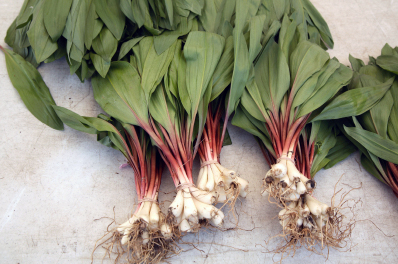by Dustin Skelley, Prepared Foods Category Manager
 Each spring I look forward to my annual pilgrimage to forage for wild ramps, it’s one of the first foraging crops to emerge in the spring. For me, ramps are the inaugural crop for the local season and a sign that warm weather is here and a reminder of all the great crops that are just around the corner! For those of you who are not sure what ramps are, they’re a wild onion native to North America; they’re most abundant in the Eastern parts of the United States and Canada (from Western Minnesota all the way to Maine and as far south as Kentucky/Tennessee). They can be found in rich, moist soils, typically beneath deciduous trees, and are mostly available in the mid-to-late spring, depending on the weather. Ramps typically start emerging from the soil as we start to get consistently warmer weather and as the tree canopy above them starts to develop and leaf out.
Each spring I look forward to my annual pilgrimage to forage for wild ramps, it’s one of the first foraging crops to emerge in the spring. For me, ramps are the inaugural crop for the local season and a sign that warm weather is here and a reminder of all the great crops that are just around the corner! For those of you who are not sure what ramps are, they’re a wild onion native to North America; they’re most abundant in the Eastern parts of the United States and Canada (from Western Minnesota all the way to Maine and as far south as Kentucky/Tennessee). They can be found in rich, moist soils, typically beneath deciduous trees, and are mostly available in the mid-to-late spring, depending on the weather. Ramps typically start emerging from the soil as we start to get consistently warmer weather and as the tree canopy above them starts to develop and leaf out.
Ramps have a unique taste, a bit like a leek or scallion but with more of a garlic-forward bite. Both the bulb and the leaves are edible, but each has a different texture and application. The leaves are broad and a bit stringy with a bit more of that fresh garlic taste. The bulbs are moist and layered like an onion and have a much more onion-forward taste. I enjoy using the bulbs in lieu of onions in recipes, or by thinking of different ways to highlight their unique shapes and tastes into traditional dishes. You can use the broad leaves to wrap up small morsels of trout (or other whitefish) or you can puree the leaves to disperse that onion flavor throughout a dish—or make a delicious pesto! The bulbs can be sliced just like a scallion, and used like an onion. My favorite thing to do with the bulbs is to quick-pickle them so that I can enjoy them into the summer months!
Ramps can be farmed and planted commercially, but it’s more fun to hike about the woods and find them on your own! One of my favorite spots in Wisconsin to find ramps is Washington Island; each time I’ve gone hiking on Washington Island in late May I’ve been able to find more than can possibly be harvested. It’s easy to tell when you’re nearing a patch because they emit a strong onion-like odor. The most important thing to remember when harvesting ramps is to not harvest the entire patch, but rather only take a portion of it. That way they’ll be able to repopulate and you’ll be able to harvest the same spot next year. Have fun foraging and always forage responsibly!